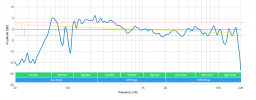There is more to it than just a "house curve". Here are a few industry guidelines:
In 1974, Bruel and Kjaer instruments wrote an application note on, "
Relevant loudspeaker tests in studios in
Hi-Fi dealers' demo rooms in the home etc. using 1/3 octave, pink-weighted, random noise." See Figure 5:
"The optimum curve for HIFI equipment measured in the actual listening room." While the curve is smooth, it
does have a gradual roll-off. Looking at the frequency response plot, the gradual roll-off starts at -0.5 dB at
200 Hz, -3 dB at 2 kHz, and -6 dB down at 20 kHz. Over time, this became known as the B&K "house
curve." For decades, professionals and amateurs alike have used the B&K house curve (or target response)
when equalizing a sound reproduction system for critical listening purposes.
In 1994 (updated in 2015), the ITU produced a "
Recommendation ITU-R BS.1116-3 (02/2015) Methods for the
subjective assessment of small impairments in audio systems." On Page 17, section 8.3.4.1 Operational
room response curve shows a tolerance limit of ±3 db SPL and a very similar operational room response
curve as per EBU-Tech 3276 below.
In 1998, the European Broadcast Union produced a Tech note, EBU-Tech 3276, “
Listening conditions for the
assessment of sound programme material: monophonic and two–channel stereophonic." See Figure 2 on
Page 6: "Tolerance limits of the operational room response curve." The curve is flat to 2 kHz and then a
straight line to -6 dB at 20 kHz with a ±3 dB tolerance along the target. As mentioned previously, this Tech
note has other target specifications that we will examine in upcoming sections.
In 2009, Dr. Sean Olive from Harmon wrote a paper on, "
The Subjective and Objective Evaluation of Room
Correction Products."
Presentation download. Through the use of measurements and listening tests, the
preferred response is a straight line, but tilted starting at +2 dB at 20 Hz to -8 dB at 20 kHz. The conclusion
is that flat in-room response is not the preferred target response.
In 2015, Dr. Floyd Toole wrote an AES open access paper on, "
The Measurement and Calibration of Sound
Reproducing Systems." See Figure 14 "Subjectively preferred steady-state room curve targets in a typical
domestic listening room [49], from Olive et al. [48]. The prediction of Fig. 13(a) is superimposed." Note that
the trained listener's preference target curve is similar to the other targets referenced above.
Overlaying the "house curves" or target responses:
View attachment 10874
Coincidence...

Personally, I favour the Olive/Toole house curve (or really, tilt). I have tried most of those "curves" in many, many rooms, including several recording studio control rooms, with many speakers, including live sound reinforcement systems over a... gulp... 38 year time span. Starting with a 10 band analog eq all the way to state of the art DSP, as can be seen in my sig.
While there are other contributing factors, i.e. physical shape of the room, how live or dead, one can't go too wrong by starting with any one of these house curves. Especially, if one is using modern DSP, each one can be compared in real time and fined tuned to one's personal preference.





